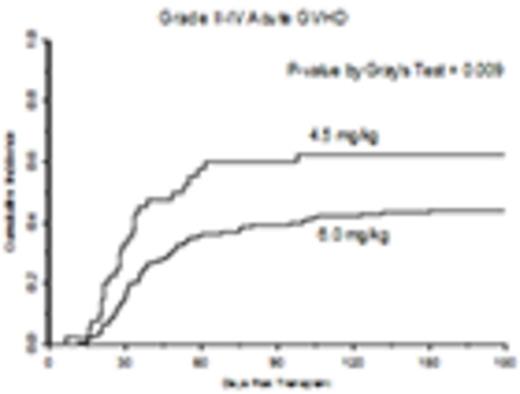Abstract
Introduction: The appropriate dose of antithymocyte globulin (ATG) to be used in reduced-intensity conditioning (RIC) allogeneic hematopoietic stem cell transplantation (allo-HSCT) is yet to be determined. In our previous retrospective analysis we compared two dosing schedules of ATG (7.5 mg/kg vs 6 mg/kg) in 136 patients who had undergone RIC allo-HSCT, and found no significant differences in the incidence of acute or chronic graft-versus-host disease (GVHD), non-relapse mortality (NRM), relapse, progression-free survival (PFS) or overall survival (OS). As of October 2013, our ATG dosing was lowered from 6.5 to 4.5 mg/kg. We now compare the outcomes of patients who received ATG at a dose of 4.5 mg/kg (r-ATG) to 6 mg/kg (R-ATG)
Methods: We retrospectively analyzed the outcomes of patients who underwent unrelated or mismatch related RIC allo HSCT for hematologic malignancies and received r-ATG (40 patients) vs R-ATG (216 patients) at The Ohio State University Comprehensive Cancer Center between October 2007 and September 2014. Cumulative incidences of GVHD, infection, NRM, and relapse were analyzed using Gray's test, accounting for competing risks. PFS and OS were analyzed using the log-rank test.
Results: Patients with hematologic malignancies included AML/MDS (53%), NHL/Hodgkin's (19%), CLL (12%), and other hematologic malignancies including ALL (16%). There was a significant association between disease group and ATG dose (p<0.001), with none of the patients diagnosed with CLL receiving r-ATG and a higher percentage of those with other malignancies receiving r-ATG vs R-ATG than expected. Secondary to the imbalance in disease groups, those receiving r-ATG were younger (median 50 vs 59 yrs, p=0.01) and more likely to have bone marrow stem cell source (18% vs 5%, p=0.008). There were no significant differences in recipient or donor sex, degree of HLA match, prior autografts, comorbidity index, donor/recipient CMV status and CD34 cell dose between the two groups. The cumulative incidences of acute GVHD grade II-IV at day 180 in the r-ATG and R-ATG groups were 63% and 44% (p=0.009), and of grade III-IV 18% and 11% (p=0.25) respectively (Figure 1A and B). When controlling for differences in underlying disease, the estimated risk of acute GVHD grade II-IV was 1.6 times higher with r-ATG (p=0.04). The respective cumulative incidences at 6 months of chronic GVHD were 14% and 16% (p=0.65), and of extensive chronic GVHD 14% and 13% (p= 0.29). With limited follow-up in patients receiving r-ATG (median 10 months), significant differences were not observed in longer-term outcomes between the two groups including relapse rate (p=0.83), NRM (p=0.91), PFS (p=0.92), and OS (p=0.996). The incidence of CMV reactivation at day 180 was lower in the r-ATG group (5% vs 26%, p=0.005), though the incidence of competing risks including GVHD, relapse and death prior to documented reactivation was higher in the r-ATG group (p<0.0001). No statistically significant differences were seen in Epstein-Barr virus reactivation (p=0.74), BK-virus associated hemorrhagic cystitis (p=0.79), bacterial infections (p=0.11), or Clostridium Difficile infections (p=0.22).
Conclusions
While there was an increase in grade II-IV acute GVHD with r-ATG, there was no significant difference in acute GVHD grade III-IV, relapse, NRM, PFS and OS between the two cohorts. r-ATG resulted in a lower proportion of CMV reactivation, but in a higher proportion of other competing risks. Given the increasing use of RIC allo-HSCT for treating malignant hematologic conditions, the correct dose and schedule of ATG administration should be defined by prospective randomized controlled trials.
No relevant conflicts of interest to declare.
Author notes
Asterisk with author names denotes non-ASH members.



